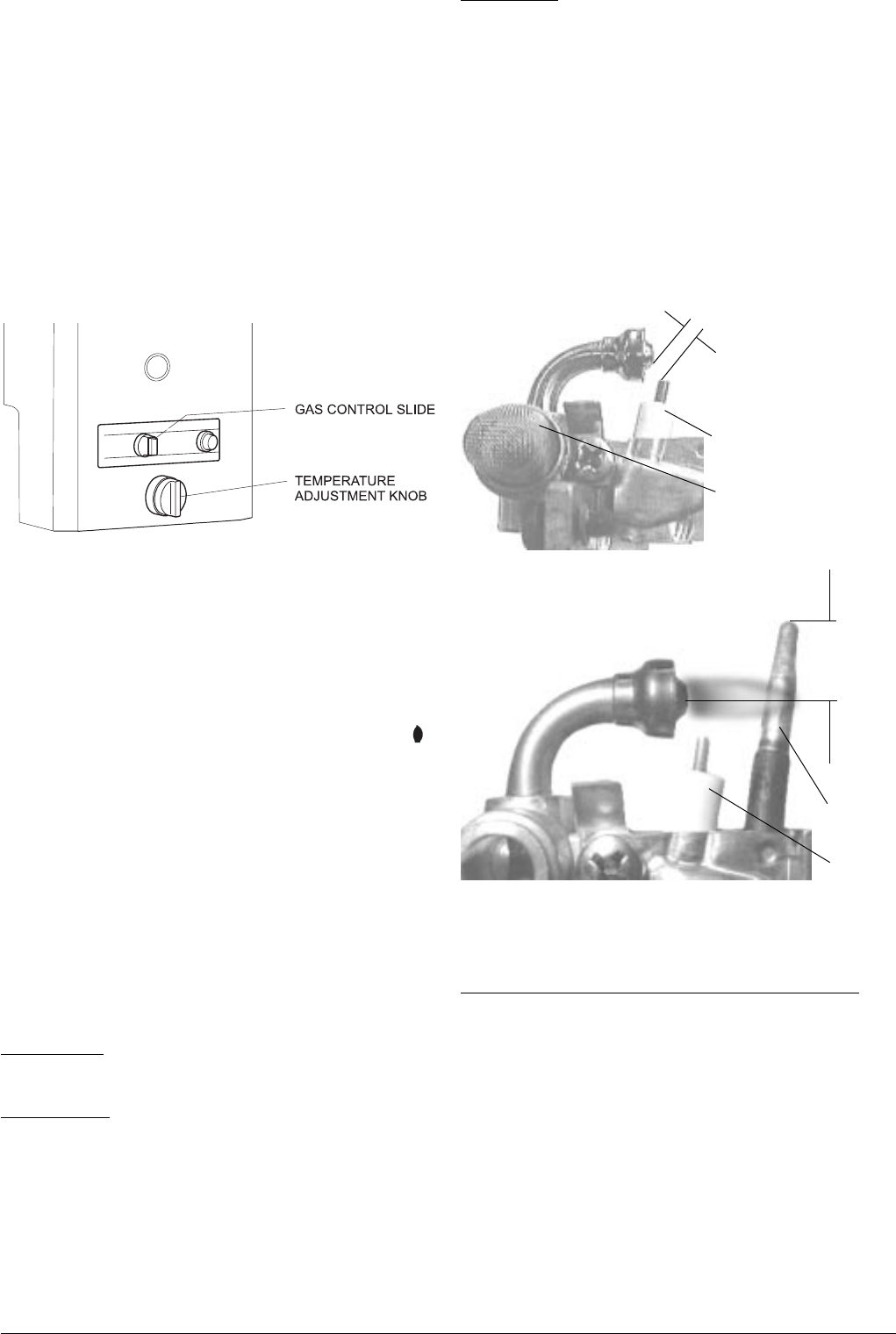
12 6 720 606 446
Fig. 6 - Water Flow Control Knob
The position you select on the temperature adjustment knob
will depend on the temperature of the incoming water (50°F
is average in the U.S.). If you plan to supply the AquaStar
38 B, with preheated water (i.e.) solar installation, the unit
could overheat. It will then shut off on safety when the
outlet temperature reaches 185°F. For a lower temperature
rise, the heater can be set for minimum burner output by
sliding the gas valve control to the pilot setting symbol ( ).
MAINTENANCE AND SERVICE (see maintenance
table on back)
Approximately once a year, the AquaStar should be checked
and cleaned. To remove the front cover, first remove the
incandescent particle tray, then pull off the temperature
adjustment knob, unscrew and remove the plastic collar and
unscrew the central screw located at the bottom of the front
cover. Pull main cover out toward you and lift up and out.
THE FOLLOWING OPERATIONS SHOULD BE
PERFORMED BY A QUALIFIED SERVICE PERSON:
Vent System: Should be checked annually. Clean and repair
as needed.
Water Valve (Part # 8707002497): The water valve on
this heater should be serviced periodically. Lubricate com-
ponent #19 on page 18 with a small amount of silicon,
faucet or lithium grease every two years to keep its o rings
fresh and pushrod sliding smoothly. Every 3-5 years replace
components #19 and #21 on page 18. The frequency will
depend on the mineral content of the water and conditions
of use or whenever signs of corrosion appear at the gas and
water valve joint. Periodically check that the water inlet fil-
ter (#25 on page 18) is clean as well.
3mm
Correct gap between pilot
burner tip and electrode tip
Piezo Electrode
Air screen filter
Fig. 7 - Characteristic Pilot Flame
10mm
3/8”
Piezo
Electrode
Thermocouple
To clean the pilot burner and/ or the pilot orifice : Turn
off the gas at the unit. Remove the cover of the heater. To
do so, remove the incandescent particle tray, pull off the
temperature adjustment knob and unscrew and remove the
knob collar. Unscrew the central screw located at the bottom
of the front cover. Pull main cover out toward you and lift up
and out. Pull the air screen off, wash it and blow any lint off
(See Fig 8). The pilot orifices should also be cleaned or
replaced. Do not enlarge the orifice. Do not use any wire
or sharp object to clean orifices. Natural gas orifices are
large enough that you can usually clean them by blowing
through them. LP orifices, on the other hand, are too small
to clean and should be replaced. See #3 in Trouble Shooting
Section. To access the pilot orifice, remove 2 screws holding
pilot assembly in place. Then loosen compression fittings to
expose pilot orifice.
Pilot Flame: The pilot flame should burn with a clean sharp
blue flame and should resemble the diagram in Fig 7. If the
flame is yellow, or if the pilot knob has to remain depressed
for a long time in order to keep the pilot lighted, the pilot
burner and or the pilot burner orifice may need to be cleaned,
the orifice may need to be replaced, and or the air screen or
pilot gas filter may need cleaning. The pilot flame should
envelop approximately 10 mm (3/8") of the tip of the
thermocouple. If it is too small, the pilot burner must be
cleaned. The position of the Piezo igniter electrode should
be approximately 3 mm (1/8") from the pilot.
SETTING THE WATER TEMPERATURE
To adjust the temperature on your AquaStar, turn on a hot
water faucet to its maximum flow.At the water heater, turn
the large temperature adjustment knob located beneath the
main gas controls on the front of the heater all the way to
the right (clockwise). See Fig 6. This will produce a
temperature rise of approximately 90°F at a flow rate of .5
gallons per minute (gpm). Turning the dial all the way to the
left (counterclockwise) will increase the water flowing through
the heater, and will produce a temperature rise of
approximately 45°F at a flow rate of 1.3 gpm. Given that
average incoming water temperatures are 50°F, this heater
will produce water between 140° and 95°
at these flow
rates. Thus one can obtain a higher flow rate, but at cooler
temperatures.


















